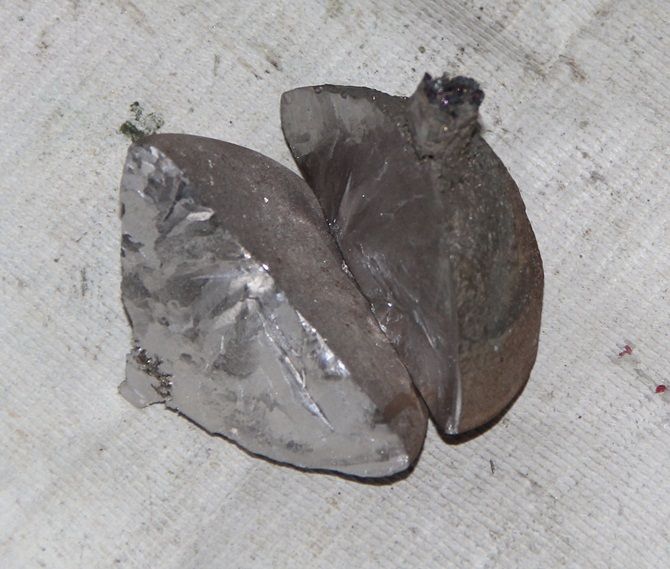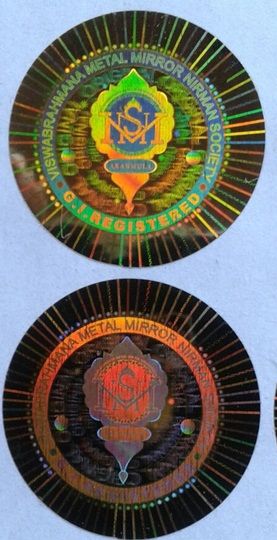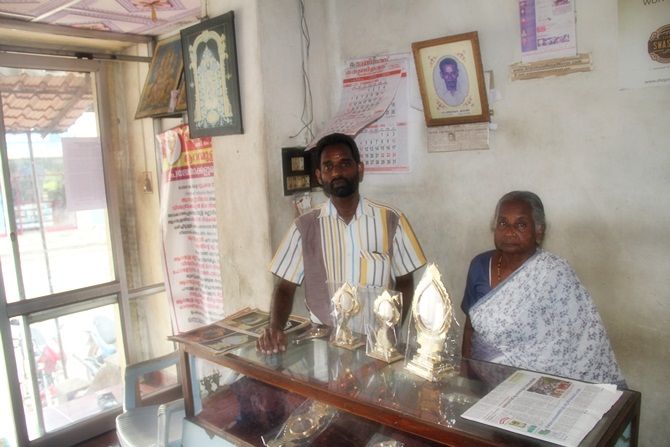With fake products making its way into the market, Aranmula's metal mirror makers are finding new ways to keep the glory of the traditional craft intact, finds Manu A B/Rediff.com

The traditional craftsmen of 'Aranmula Kannadi' - the handmade metallic mirrors made in a small town in south Kerala - are fighting a lone battle against counterfeit mirrors in the market.
The mirror’s metal alchemy, which is still a closely guarded secret among 19 craftsmen, got a major recognition with the GI (Geographical Indication) patent tag in 2003, which means that it can only be made in Aranmula by registered members, but counterfeiters who were arrested recently, took advantage of the fact that the metallurgical marvel has generated huge demand in India and abroad.

These metallic mirrors, made from an alloy of ‘tin and copper’, are part of a 500-year-old cultural lineage and its secret metallic composition is known only to a few remaining families hailing from the Vishwa Brahmana community in Aranmula in Pathanamthitta district.
The mirror is made-to-order and the price ranges from Rs 800 to Rs 100,000 depending on its size. One can choose the size of the mirror and the frame designs, which are made in brass. 
Recognising its iconic status, the Kerala government declared that the Aranmula mirror would be the official memento to be presented to important personalities who visit the state.
Metal mirrors, which came into existence from the early 16th century and were made by just few families are now threatened by fake products and machine made ones, which do not last long.
Traditional mirror makers are fighting to keep the glory of the metal mirror alive by adopting technologies like Hologram.

“Our age-old craft is getting threatened by counterfeiters and unscrupulous agents who make these mirrors with machines or use a different mix of the alloy to make a quick buck. We have received several complaints about defective products as well, Customers should always check for the hologram behind the mirror before buying it,” says A K Selvaraj, president of the Vishwa Brahmana Aranmula Metal Mirror Nirman Society.
Selvaraj’s efforts to protect the 'Aranmula Kannadi' led him to form a society of traditional craftsmen. He also took the initiative to get the coveted GI status for the mirror.

Aranmula Kannadi - A metallic wonder
In the corner of his noisy workshop, Selvaraj’s brother Gopalakrishnan is giving final touches to a shiny well decorated mirror. He has been polishing the mirror since a week on a rugged jute cloth laced with oil so that it reflects any image to perfection.
Unlike ordinary mirrors, these metal mirrors reflect the real picture with clarity.
From a young age of 14, Selvaraj has been actively involved with the making of mirrors. He believes that he has ‘inborn’ qualities to make these beautiful mirrors. His family has been carrying forward the tradition of making mirrors since 3 generations – around 100 years.

Since I looked weak, my father was always skeptical of whether I can carry forward this tradition of making metal mirrors. It needs a lot of involvement, patience and hours of hard work to make a mirror,” says Selvaraj.
Completely hand-made from a unique alloy of copper and tin, the world-famous metal mirror is now made by 19 registered craftsmen in Aranmula. “We first received a GI certification in 2003. It was a turning point in our business. Sales improved considerably after we received the GI tag. It gives us the sole right to make the mirrors,” says Selvaraj, who also owns the Parathasarthy Handicrafts Centre.

A big move to counter fake metal mirrors
Four decades ago, Selvaraj’s father was the only one making metal mirrors. Today there are 19 units, including two run by women making and selling these mirrors.
The Vishwa Brahmana Aranmula Metal Mirror Nirman Society has now taken a tough stand against counterfeiters and plans to work with more rigour to save this traditional craft of Kerala. “Last week, we filed a complaint and closed down a shop which was selling fake mirrors,” says Selvaraj.

The society has submitted a proposal to the government to grant funds to build a common unit to make the alloy so that the mixture remains uniform in all the units. “We are hopeful that the government will take a positive step in helping us preserve this age-old tradition,” explains Selvaraj.
On an average the 19 registered units of the society sell 300 mirrors every month. Two decades ago, they used to wait for months together to sell one mirror but now things have changed for the better. Selvaraj’s store alone sells around 35 pieces every month.

Legend behind the metal mirror
It is believed that eight families who had expertise in temple art were brought to Aranmula from Tirunelveli district in Tamil Nadu.
The artisans who built the famous Parthasarathy Temple in Aranmula found the reflective properties of metal while they were making a crown for Lord Parthasarathy.
The idea of making a mirror from metal seemed like a dream. They, however, could not replicate it for making a mirror. It is believed that a widow from the community Parvathy, had a divine power telling her the secret ratio to make the metal mirror. Hence, the mirror is considered to be divine gift from God.
The art of making the mirror was then passed on to future generations.

A gifted family
It is a painstaking and labourious process which needs great perseverance, creativity and dedication.
Selvaraj’s father, V K Arjunan Achari was a master craftsman who passed on the tradition of making mirrors to Selvaraj and his brother.
"My father was a perfectionist. He used to just show me how to do a certain thing without talking. He wanted us to learn everything by keenly observing the process of making the mirrors.”
Selvaraj and others in the trade face problems of getting skilled labour. More than work, it is a fine art so it needs days of dedicated service.

“We face shortage of labour. With modernisation, jewellery making and making artifacts from brass has come to a standstill. Now, mirror work is the only traditional craft that is left to sustain ourselves. We hope the popularity of the mirrors grows so that this art form will live forever,” Selvaraj says.
In 1962, Arjunan Achari started training other people to make mirrors in order to keep the tradition of Aranmula mirrors alive.
Most of the mirror makers today are either his students or have mastered the art working with him at some point, explains Selvaraj.
Recently, a person who studies palmistry of artists took images of our palms and said there is something distinct and artistic about our family, says Selvaraj.

Making of the mirror
The special kind of mud needed to make the mirror is procured from the paddy field in Aranmula. Ironically, this vast expanse of paddy fields are part of the land acquired for the proposed Aranmula International Airport project, which has been halted after a Supreme Court verdict.
Mud is powered to make a fine paste which is then used to make a mould in circular or square shapes.
Two flat moulds are attached leaving a small gap in between with wax. 
After the mould is fully sealed in the form of a bottle, the alloy is placed on the small opening on the mouth of the bottle-shaped mould and sealed with mud and heated in the fire for about 400 degree centigrade for 2-3 hours, the alloy melts and moved into the mould.
Once cooled, the mud covering is broken and a flat piece of metal is taken out. This metal is then cut into circular or oval shapes. After polishing for days together, the blank metal turns into a shiny mirror. All the processes are done manually.

A gift treasured by the world
On the dim-lit walls of Parthasarathy Handicraft Centre, there are photographs of former president APJ Abdul Kalam, Kapil Dev, Sachin Tendulkar receiving the mirrors as a memento during the different events they attended in Kerala.
Selvaraj takes pride in the fact that these finely crafted mirrors were made in his small workshop.
Aranmula, which is also famous for boat races, attracts tourists from India and abroad. Foreigners are more interested in watching the entire process of how the mirror is made, says Selvaraj.

What makes the Aranmula Kannadi so special
The mirrors are considered to be among the eight auspicious items or that make up a bride’s prized possession. The mirror is believed to bring good luck and prosperity to the people who possess it.
“One customer told me that his daughter got a good marriage proposal after he kept the mirror in his house. Another businessman said he saw an improvement in business after he kept a mirror in his office. Foreigners are amazed by the beauty and like to visit our workshop to see every process of how the mirror is made. The British Museum in London too has Aranmula mirror in its collection.

“Apart from work on the frames, the fascinating aspect is that the mirror is hand-made. Right from casting to finishing, it requires intensive labour. It’s hard to find trained workers these days and material costs have increased a lot, but we are hanging on because this is what we’ve been picked to do,” says Selvaraj.
He supplies the mirrors in bulk to government and private organisations as the ‘Aranmula Kannadi’ is a favourite gifting option during conferences and big events.
Taking a piece of paper, Selvaraj explains the difference between ordinary mirror and the metallic mirror, “In an ordinary mirror, when you touch a piece of paper on the surface of an ordinary mirror, there appears a gap between the object and the image, whereas in the Aranmula metal mirror the paper and its reflection actually touch and there is no gap between the images.”

Will it survive the test of time?
With fake products and machine-made mirrors making its way into the market, an age-old art form is under threat.
“If people get cheated with inferior products, then our products will lose its brand value. It’s our duty to preserve and protect this amazing craft for generations to come. We now check every piece of mirror made by society and give hologram stickers. Customers must check the product for the hologram and also carefully look at the mirror to see if there are any distortions, points out Selvaraj.
As president of the society, Selvaraj makes sure the mirrors certified are perfect before giving it a hologram mark.
Moving towards a more integrated and foolproof method to check corruptive practices, Selvaraj and 18 members of the society have decided to make the alloy at a common workshop so that all the artists in the society get the right proportion of the alloy to make mirrors.
"If we use the accurate proportion of tin and copper, the real hand-made metal mirror will crack if it falls down, whereas a spurious one will not break if it falls but will turn dark after a few years,” explains Selvaraj.
The government has assured them support to build the industry on a strong footing. “With government’s help, we can jointly work towards saving the Aranmula mirror from the hands of unscrupulous agents, improve its brand value and build a bright future for this traditional art.”







